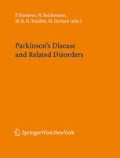Summary
Dopamine belongs to the most intensively studied neurotransmitters of the brain, because of its implications in psychiatric and neurological disorders. Although, clinical relevance of midbrain dopaminergic (mDA) neurons is well recognized and dopaminergic dysfunction may have a genetic component, the genetic cascades underlying developmental processes are still largely unknown. With the advances in molecular biology, mDA neurons and their involvement in psychiatric and neurological disorders are now subject of studies that aim to delineate the fundamental neurobiology of these neurons. These studies are concerned with developmental processes, cell-specific gene expression and regulation, molecular pharmacology, and genetic association of dopamine-related genes and mDAassociated disorders. Several transcription factors implicated in the post-mitotic mDA development, including Nurr1, Lmx1b, Pitx3, and En1=En2 have contributed to the understanding of how mDA neurons are generated in vivo. Furthermore, these studies provide insights into new strategies for future therapies of Parkinson’s Disease (PD) using stem cells for engineering DA neurons in vitro. Here, we will discuss the role of Pitx3 in molecular mechanisms involved in the regional specification, neuronal specification and differentiation of mDA neurons.
Access this chapter
Tax calculation will be finalised at checkout
Purchases are for personal use only
Preview
Unable to display preview. Download preview PDF.
References
Chung S, Hedlund E, Hwang M, Kim DW, Shin BS, Hwang DY, Jung Kang U, Isacson O, Kim KS (2005) The homeodomain transcription factor Pitx3 facilitates differentiation of mouse embryonic stem cells into AHD2-expressing dopaminergic neurons. Mol Cell Neurosci 28: 241–252
Greene JG, Dingledine R, Greenamyre JT (2005) Gene expression profiling of rat midbrain dopamine neurons: implications for selective vulnerability in parkinsonism. Neurobiol Dis 18: 19–31
Grimm J, Mueller A, Hefti F, Rosenthal A (2004) Molecular basis for catecholaminergic neuron diversity. Proc Natl Acad Sci USA 101: 13891–13896
Hwang DY, Ardayfio P, Kang UJ, Semina EV, Kim KS (2003) Selective loss of dopaminergic neurons in the substantia nigra of Pitx3-deficient aphakia mice. Brain Res Mol Brain Res 114: 123–131
Hwang DY, Fleming SM, Ardayfio P, Moran-Gates T, Kim H, Tarazi FI, Chesselet MF, Kim KS (2005) 3,4-dihydroxyphenylalanine reverses the motor deficits in Pitx3-deficient aphakia mice: behavioral characterization of a novel genetic model of Parkinson’s disease. J Neurosci 25: 2132–2137
Hynes M, Rosenthal A (1999) Specification of dopaminergic and serotonergic neurons in the vertebrate CNS. Curr Opin Neurobiol 9: 26–36
Nunes I, Tovmasian LT, Silva RM, Burke RE, Goff SP (2003) Pitx3 is required for development of substantia nigra dopaminergic neurons. Proc Natl Acad Sci USA 100: 4245–4250
Perlmann T, Wallen-Mackenzie A (2004) Nurr1, an orphan nuclear receptor with essential functions in developing dopamine cells. Cell Tissue Res 318: 45–52
Puelles L (2001) Brain segmentation and forebrain development in amniotes. Brain Res Bull 55: 695–710
Simon HH, Thuret S, Albéri L (2004) Midbrain dopaminergic neurons: control of their cell fate by the engrailed transcription factors. Cell Tissue Res 318: 53–61
Smidt MP, Smits SM, Burbach JPH (2004a) The homeobox gene Pitx3 and its role in the development of dopamine neurons of the substantia nigra. Cell Tissue Res 318: 35–43
Smidt MP, Smits SM, Bouwmeester H, Hamers FP, van der Linden AJ, Hellemons AJ, Graw J, Burbach JPH (2004b) Early developmental failure of substantia nigra dopamine neurons in mice lacking the homeodomain gene Pitx3. Development 131: 1145–1155
van den Munckhof P, Luk KC, Ste-Marie L, Montgomery J, Blanchet PJ, Sadikot AF, Drouin J (2003) Pitx3 is required for motor activity and for survival of a subset of midbrain dopaminergic neurons. Development 130: 2535–2542
Verney C, Zecevic N, Puelles L (2001) Structure of longitudinal brain zones that provide the origin for the substantia nigra and ventral tegmental area in human embryos, as revealed by cytoarchitecture and tyrosine hydroxylase, Calretinin, Calbindin, and GABAimmunoreactions. JCompNeurol 429:22–44
Zhao S, Maxwell S, Jimenez-Beristain A, Vives J, Kuehner E, Zhao J, O’Brien C, de Felipe C, Semina E, Li M (2004) Generation of embryonic stem cells and transgenic mice expressing green fluorescence protein in midbrain dopaminergic neurons. Eur J Neurosci 19: 1133–1140
Author information
Authors and Affiliations
Editor information
Editors and Affiliations
Rights and permissions
Copyright information
© 2006 Springer-Verlag
About this paper
Cite this paper
Smits, S.M., Smidt, M.P. (2006). The role of Pitx3 in survival of midbrain dopaminergic neurons. In: Riederer, P., Reichmann, H., Youdim, M.B.H., Gerlach, M. (eds) Parkinson’s Disease and Related Disorders. Journal of Neural Transmission. Supplementa, vol 70. Springer, Vienna . https://doi.org/10.1007/978-3-211-45295-0_10
Download citation
DOI: https://doi.org/10.1007/978-3-211-45295-0_10
Publisher Name: Springer, Vienna
Print ISBN: 978-3-211-28927-3
Online ISBN: 978-3-211-45295-0
eBook Packages: MedicineMedicine (R0)

